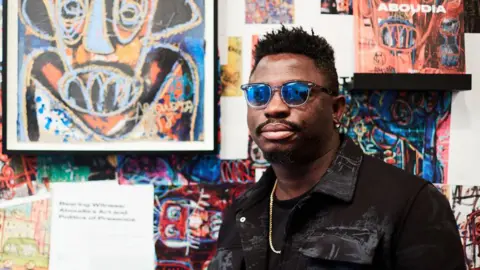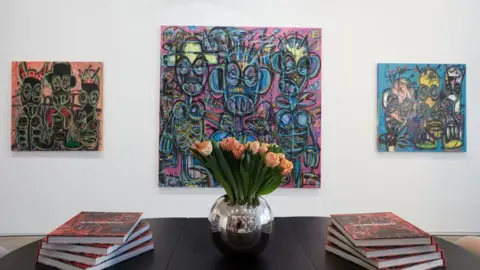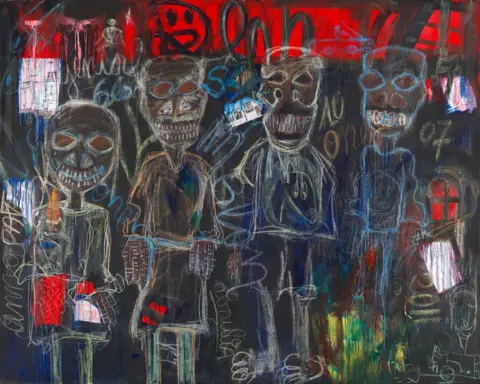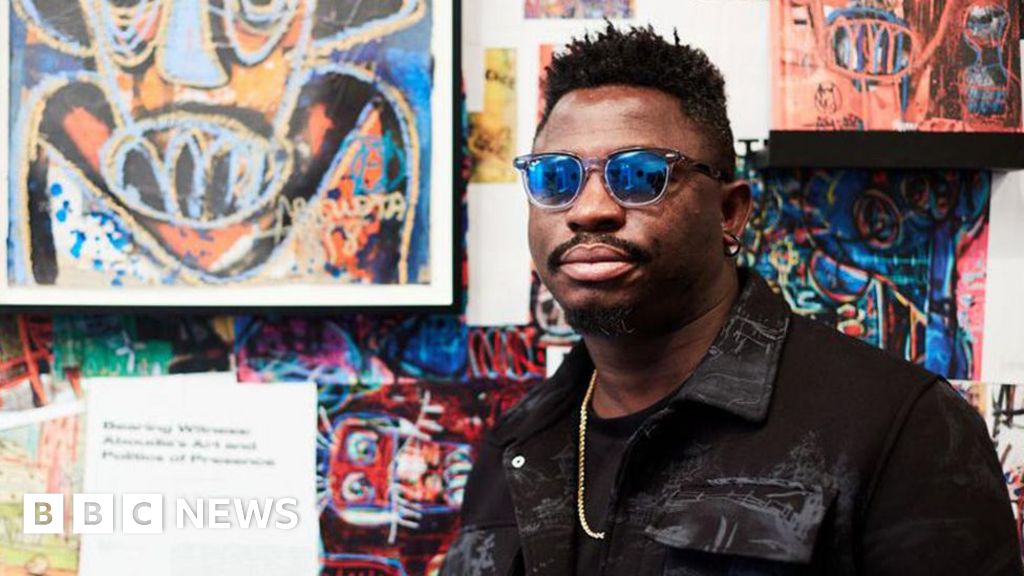Wedaeli Chibelushi,BBC News, London
 Larkin Durey
Larkin DureyBack in September, global art experts were taken aback by the name topping a fresh list of the world’s best-selling artists.
Aboudia, a graffiti-inspired artist from Ivory Coast, had beaten well-known names, like Damian Hirst and Banksy, to sell the most pieces at auction the previous year.
According to the Hiscox Artist Top 100, Aboudia, real name Abdoulaye Diarrassouba, had flogged 75 lots. One of these canvasses had gone for £504,000 (£640,000).
Leading online marketplace Artsy called Aboudia’s triumph “striking”, while The Guardian said market experts were “blindsided” by the ranking.
Months later, sat in a London gallery plastered with his paintings, Aboudia tells me the survey results were “no surprise” to him.
“Because if you work hard, the success is going to come,” he says, dressed entirely in black save for wristfulls of beaded bracelets.
“The first thing is your work… after, everything comes home.”
Aboudia’s mellow disposition clashes with the art surrounding him – his vividly coloured, heavily layered canvases feature a cast of cartoon-like figures plucked from the streets of Abidjan, Ivory Coast’s largest city.
Through a blend of oil sticks, acrylic paints and recycled materials like newspapers, Aboudia depicts the hardships of life in downtown Abidjan. He particularly focuses on the children who live and work on the city’s streets.
His eyewitness portrayals of Ivory Coast’s 2011 civil war are equally arresting. Figures gaze at the viewer with vacant eyes, while armed soldiers and skulls crank up the intensity.
Aboudia says that today, there’s a misconception that his rise to the top “came quickly”.
“No – I worked like 15 or 10 years for that.”
 Larkin Durey
Larkin DureyAboudia was born in 1983, in Abengourou, a small town around 200km (124 miles) from Abidjan. In a 2012 essay, the artist said he was kicked out of his home aged 15 after telling his father he wanted to paint for a living.
After being cast out, the young Aboudia pressed on and enrolled in art school. Due to a lack of financial support, he slept in his classroom after the other students went home for the day. These uncomfortable nights paid off – after graduating in 2003 the soon-to-be-star was accepted into Ivory Coast’s leading art school, École des Beaux-Arts.
Abidjan’s École des Beaux-Arts would expose Aboudia to the Ivorian art icons whose influence can be found in his current work. For instance, Aboudia’s focus on his direct surroundings and his use of recycled materials can be traced back to Vohou Vohou, a modernist collective established in the 1970s by artists like Youssouf Bath, Yacouba Touré and Kra N’Guessan.
Aboudia began to veer away from traditional styles of art, instead using untamed brushstrokes and earthy colours to recreate graffiti produced by Abidjan’s underprivileged children.
In Aboudia’s words, these young, de facto street artists “draw their dreams on the world”.
The children are his main influence, he says, and not the wildly famous, American graffiti artist-turned-painter that his work is often likened to.
“When I started working, I didn’t know [Jean-Michel] Basquiat,” Aboudia says.
“It wasn’t like: ‘There’s a person called Basquiat, there’s a person called Picasso’ because there wasn’t internet at the school and they didn’t talk about those artists.”
After establishing his core style, Aboudia would lug his paintings around the galleries of central Abidjan, hoping for a way in.
“It was very hard… they’d say: ‘Are you crazy? What is this work? You better go to London, to United States or Paris, because this work… here it doesn’t make sense’,” Aboudia recalls.
 Aboudia/Larkin Durey
Aboudia/Larkin DureyThe adversity did not end there. In 2010, Laurent Gbagbo, the then president of Ivory Coast, refused to step down after losing an election to rival Alassane Ouattara. A civil war broke out, killing 3,000 people and forcing another 500,000 from their homes.
Throughout the four-month conflict, Aboudia sought refuge in his basement studio, documenting the horrors he saw when venturing above ground.
The war ended with Mr Gbagbo’s dramatic capture by UN and French-backed troops – and Aboudia emerged from his haven with 21 disconcerting paintings.
Art-lovers and journalists from Ivory Coast and beyond lauded his work and Aboudia’s ascent to global success began.
He was championed by renowned art collectors Charles Saatchi and Jean Pigozzi – and went on to exhibit his work at prestigious venues like Christie’s New York and the Venice Biennale.
Aboudia’s first solo exhibition was at the setting for this interview, London’s Larkin Durey (then named the Jack Bell gallery).
Owner Oliver Durey, who has now known Aboudia for over a decade, tells the BBC: “There is something we can all relate to in his paintings; hiding amidst the uncertainty and horror there are balanced moments of strength and beauty.”
African art expert Henrika Amoafo says Aboudia’s art “kind of fits the international idea of Africa representing war” and other forms of strife.
There are other reasons for his success though, like his “authenticity, the really raw emotional power that he’s able to convey, the way that he speaks to urban life, the way that he speaks about conflict and its impact on children”, says Ms Amoafo, an executive at ADA Contemporary Art Gallery in Ghana.
 Aboudia/Larkin Durey
Aboudia/Larkin DureyAboudia’s rise also coincides with that of the African art market. In 2021, art analysis firm ArtTactic reported that the auction sales value of contemporary and modern African art surged by 44% to a record high of $72.4m (£56.9m).
ArtTactic has also found that while the global art market declined by 18% last year, Africa’s only shrunk by 8.4%.
In its 2024 assesment of the industry, Hiscox did not include a ranking of best-selling artists by the volume of all artworks sold, as it did in 2023.
However, it named Aboudia as the sixth most successful artist when it comes to pieces sold for less than $50,000 (£39,300).
Aboudia’s rise has led to him splitting his time between his country of birth and New York. When he is back in Ivory Coast, he pours his efforts into the Aboudia Foundation, an organisation he launched to support the country’s children and young artists.
This is yet another example of the star’s drive – but when I ask him if he has any plans lined up for his career, he answers plainly: “No, I don’t have that.”
When I press him, he says he takes things one day at a time – perhaps a soothing antidote to over a decade of tenacity.
You may also be interested in:
 Getty Images/BBC
Getty Images/BBC

